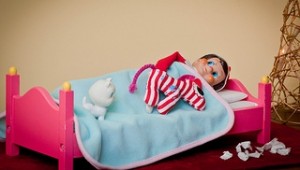There’s a family story about my wife as a little girl: while playing with her dolls, she monotoned in a creepy Children of the Corn voice, “The mother said, ‘today is my dying day.’ The mother said, ‘today is my dying day.'”
Even without the Twilight-Zone-child element, this quote has something eldritch to it. What is this “dying day” which can be identified so presciently? I thought I’d see what D&D content I could get out of it.
The “Dying Day” is obviously a high elf thing. When they enter the autumn of their lives, high elves learn the day on which their spirit will move on (barring early accidents). Knowing this would bother humans, but high elves seem fine with it. They make ready cheerily for their departure. They might even send craftsy invitations letterpressed on oak leaves: “Save the date: Lunaniel Weatherbow’s dying day is Feb 23 at the Big Tree. INVITATION TO FOLLOW”
 The deathbed is another high elf tradition. Elves don’t need to sleep (although some do for fun!), so this might be their only bed ever. It’s a big wooden affair with white sheets (symbolizing winter). Young high elves won’t use a bed with white sheets; it’s bad luck.
The deathbed is another high elf tradition. Elves don’t need to sleep (although some do for fun!), so this might be their only bed ever. It’s a big wooden affair with white sheets (symbolizing winter). Young high elves won’t use a bed with white sheets; it’s bad luck.
A day or two before your dying day, you become too listless to move: you just lie around in your deathbed looking attractively and non-specifically sick. On your dying day, all your friends visit your bedside; you clasp their hands feebly and give them each one last memento: some money, a piece of artwork, your job title, your unfulfilled quests. That’s how high elf inheritance works. If someone can’t make it to your dying day, they don’t get anything. Once you’ve said all your goodbyes, you close your eyes and drift away.
Some high elves get the urge to hurry the process. A few years or decades before their dying day, they head west, across the sea, to the mysterious homeland of the elves (Elvenhome, Feywild, Faerie, Tir Na Nog, Lyonesse, whatever it’s called in your campaign world). As soon as they reach that shore, they gain +2 Wisdom. But they will never willingly return to the mortal lands. They keep migrating west until they disappear from the world.
Wood elves? No dying day. They’ve lost that sense. And they think the whole dying-day party is creepy. Half-elves with a high elf parent DO know their dying day, but they inherit their fear of death from their human side, so it drives them CRAZY.
Here’s how you could use the dying day in a D&D campaign:








Great ideas! Hilarious picture.
“What is this “dying day” which can be identified so presciently?”
TIHS ARE AM NOT A MYSTICYCLE OR A KORN CHLDREN SAYINGS (GEWD BAND BTW)! THIS MEANS SHE WAS INN A ELECTRA-COMPLEX!!1
LOOK IT UP. CARMEN ELECTRA WAS TEH DISCROVER (BRANES AND A BEAUTY)
:p
-NUNYA
Wizards have a similar death sense in the Discworld novels, although they aren’t terribly consistent about it. I seem to recall a wizard getting a deathday party at one point.
Knowing one’s dying day makes me think of the Cyclops in Krull and the gift/curse bestowed upon them – it also beggars the question, what did the Beast in taking half the eyes of the whole race, or was their betrayal and expected misery reward enough?
As an aside, the film’s cyclops are just the right size for D&D’s cyclopskin.
Also, i might put this kind of awareness as an HALF-elf thing, a colateral manifestation of their nature as children of two worlds forever in a threshold, so to speak. Just my two cents of thought so far.
I’m fine if my D&D campaign slowly morphs into Krull.
There are mold spores in every home, but rooms with mold growth have an increase of spores in mold inspection tips
the infected are must be cleaned using HEPA air filtration and
vacuuming.
Good point, Water Damage Restoration. Mold spores will kill us all. Except the spambots.